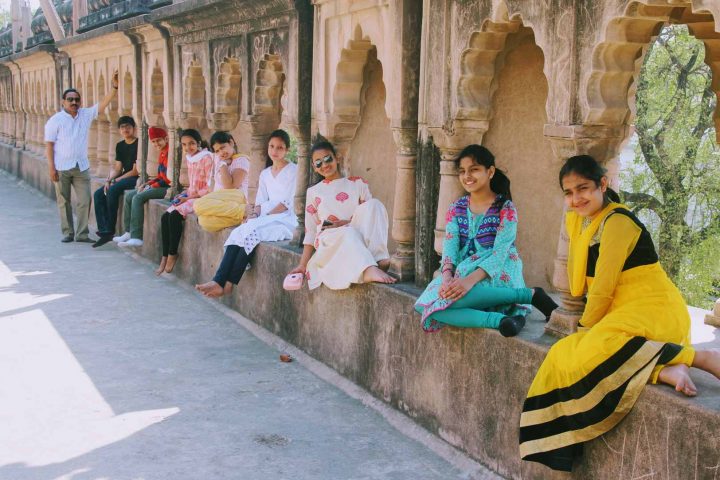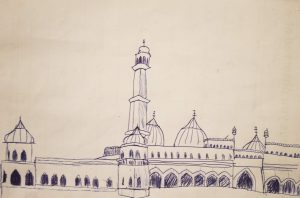
15 Mar Setting the Scene in Lucknow
Grade 6 English field trip
Last week our entire Grade 6 class went on a week-long field-trip to explore local author, Ruskin Bond’s book, A Flight of Pigeons. Using Lucknow as a backdrop in which to set the scene, the students were able to visualise the story which they had been studying.
The unit of work that Grade 6 embarks on in Social Studies and English at the start of Semester two is just amazing to teach. It is so full of learning, exploration and, dare I say, fun! In English classes Grade 6 study the novella A Flight of Pigeons by Ruskin Bond. This is the perfect accompaniment to the study of 19th century Indian history that we undertake in Social Studies and Lucknow, the ‘City of Nawabs’ is the perfect place to take the students to help them understand and experience first-hand, the events that took place in this era.
The trip involves the students re-enacting the opening scene of the book at the Lucknow Garrison Church, a visit and interview with both a Nawab and a Pathan, a tour of the Bara Imambara and an exploration of the British residency where they learn so much about the events of 1857.
It is wonderful for me as an educator, to see the kids’ learning coming to life as they see and hear about the sites and events that they have read about in A Flight of Pigeons and also the primary sources that they have studied in Social Studies. This experience would not be possible without the amazing input and organization from Mr. and Mrs. Mark who have been running the Grade 6 Lucknow trip for twelve years now.
Andy Francis, Grade 6 English Teacher
Roughly explain what A Flight of Pigeons is about.
The book is set in Shahjahanpur during the 1857 mutiny. It follows the story of a British, 14-year-old girl called Ruth. The story begins when she escapes an attack by Indian sepoys at her church. Her father is killed and she is given refuge with her mother and some others in an Indian friend’s house. The rest of the story is about how Ruth, due to the charm of her Mother, makes unlikely allies, is pursued by a man, and is in constant fear of being killed.
Anamika Seth
Did you enjoy reading and studying A Flight of Pigeons?
I enjoyed reading the book because I learnt more about Indian history. Even though sometimes the book was confusing it was easy to understand when my teacher explained it.
Golden Hubbard
How do you think being in Lucknow has helped you better understand the book and the history of 1857?
Lucknow’s historical monuments are vast and carry much historical significance of the munity of 1857. This opens a unique insight into the depths of this novella, such as the church scene in the beginning of the book. Sitting in such a similar church helps in understanding the intensity and brutality of the sepoys, but after talking to the Pathan we can say that the British were incredibly violent too. These influences are thought provoking and show the grandeur of Mughal architecture too. This gives us 6th Grade students some extraordinary views on both sides of the war. This trip has been carried out 12 times by the fabulous Mr and Mrs Mark whose hard work and dedication to create comprehensive activities has dearly paid off in a trip I won’t be forgetting about for a long time.
Arnav Kumar
What was one thing that you learnt from the trip?
I learnt the value of looking at the bias of information regarding the wars of 1857. People are always going to have differing opinions. The Pathan that we talked to supports the Indian view of the mutiny. The Nawab said that both sides made mistakes. Overall I learnt a lot about the British and Indian conflict.
Parth Chheda
What made this trip enjoyable for you?
I really enjoyed the British residency. It had so much to offer in terms of historical ruins as well as giving us the opportunity to better understand what life was like for the British in India during those times. The artifacts in the Nawabs house and the paintings in the Bara Imambara were also interesting for this reason. I also enjoyed hearing the different views of the Nawab and Pathan and comparing them.
Aadi Bhartia
A piece written by Jayant Basnyat

A sketch of the Bara Imambara by Salyan Kareki
The church was silent. The rays of the sun reflected in through the stained glass windows. I sat in awe of the pews imagining what this would be like 150 years ago. Red and brown bricks with arcs and texture, wooden pews and marble floor. A sense of history and vintage rushed through my mind. Freshly picked flowers in vases on top of the stage. Rusty metallic bells ring as chapel begins. Well decorated in the name of Christ the historical architecture grabs my eyes. Priests and Bishops loudly read verses as there are no microphones. A wooden cross on top of the belfry, people silently praying in the pews as the choir gently sings. This is the olden day church I can think of…






Jayant Basnyet
Posted at 14:14h, 04 AprilArnav’s piece was much better than mine!